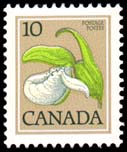Last Updated 2012 by Robin Harris
| News flash (Feb 24/03): The 2c value exists with the
hook-tag flaw! That is now ten different stamp designs with this constant plate variety. News flash: The (30c) 'A' value exists with the hook-tag flaw, inverted! That is now eleven different stamp designs with this constant plate variety. |
Back in the late 1980's, while researching an exhibit for the 1977-87 Environment definitives, I referred to information from a series of articles that ran in the early 1980's in the Canadian Philatelist (the Royal Philatelic Society of Canada's bi-monthly journal).
Study Tip#8: Study existing literature
 One of the
varieties that was noted in the July-August 1982 issue is a "hook-tag flaw" (illustrated). Unlike
other constant plate varieties, this variety occurs on different stamp issues! Impossible you say
-- read on.
One of the
varieties that was noted in the July-August 1982 issue is a "hook-tag flaw" (illustrated). Unlike
other constant plate varieties, this variety occurs on different stamp issues! Impossible you say
-- read on.
The variety was first found on the 50c Leaf vending machine booklet issued March 1, 1982 (sc 945a, bklt 82). This booklet consists of two 5c, one 10c, one 30c, and two labels. The location of the flaw is always on the right hand tag bar and falls on every 10.6 booklets (the length of the tag plate is different than the length of the printing plates). As such, the flaw will fall on the 30c Leaf (sc 945) or the label.
[As an aside, this constant plate variety is the largest found on any Canadian stamp (about 1mm wide by 4mm tall), even larger than the Extra Spire variety on the 8c Centennial sheet stamp (sc 544)].
The hook tag flaw was also found on the 1c, 2c, 3c, 5c, and 15c Flower definitives (sc 781, 782, 783, 785, 787) and 30c Leaf (sc 923) printed by the British American Bank Note Company (BABN). Thus, here is a plate variety that appears on different stamp designs! As with the 50c booklet, the hook tag flaw always occurs on the right most tag bar on the sheet. What about the other flower definitives (4c, and 10c) or other stamps current at that time? Could they have this same variety? This is just the question an accumulator of used stamps loves to hear!
It would be easy to check the 4c, and 10c Flowers but what about other stamps available at that time? A little bit of research is required to determine what other BABN stamps were current at the time the flaw was discovered.
Study Tip#9: Original research is required.
They say a picture is worth a thousand words. By creating a timeline of the Environment definitives it
is possible to easily see what other small-size definitives printed by the BABN could have the hook tag
variety. The variety appeared sometime in late 1981/early 1982, just after the postage rates were raised
from 17c to 30c but before the new low-value Artifact definitives were issued in October 1982. Thus,
the stamps that were current at that time were:

Checking our supply of used stamps, I was able to find the hook tag variety on the 1c and 10c Flower, 17c QEII sheet and booklet, 50c booklet, and 30c Leaf sheet stamps. That leaves the 4c Flower, "A" (30c) Leaf, and 30c QEII stamps as other potential stamps yet to be confirmed. Can you find the hook tag flaw on one of these stamps? These three stamps may not have been printed during the very short period when the flaw was around -- finding a stamp with the flaw will prove otherwise.
By the way, the original printings of the 1c-15c BABN stamps were released in 1979. The hook tag variety was created in late 1981/early 1982. This proves that the 1/3/5/10/15c Flower stamps were reprinted at this time and never announced. In fact, the low value Flowers underwent a number of printings as determined by other tagging characteristics (width and quality).
© 1995-2017, 2018 Robin Harris
Adminware is a trademark of Adminware Corporation.
